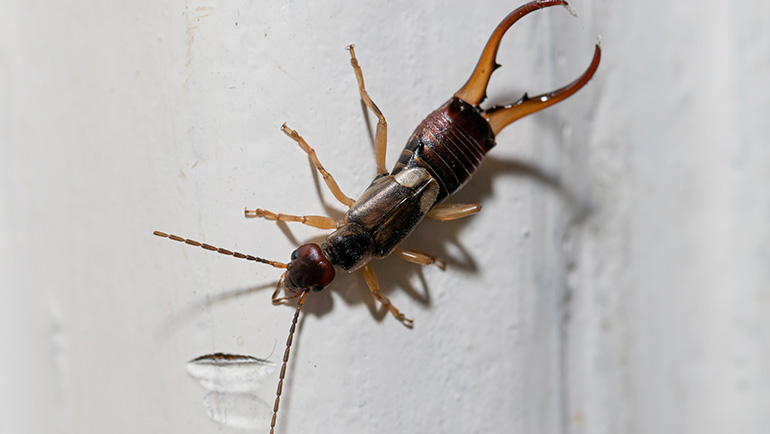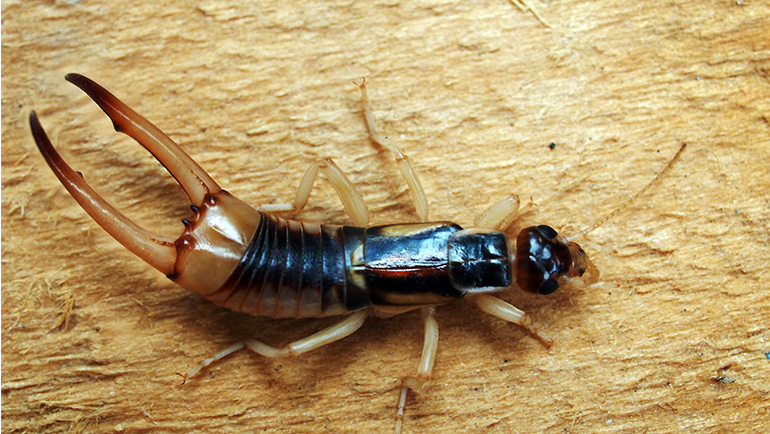Colorado’s dry summers and cool nights may not seem ideal for pests, but earwigs are a notable exception. While they don’t pose a direct health threat to humans, earwigs can become a serious nuisance when they enter homes in search of moisture and shelter. An earwig infestation often begins outdoors and quickly spreads indoors if conditions are right. Understanding their habits, entry points, and how to prevent them is essential for keeping your home protected.

What Attracts Earwigs to Your Property?
Earwigs are nocturnal insects that thrive in damp, dark, and cool environments. Outdoors, they often hide under mulch, stones, firewood, and garden debris during the day. When the weather turns dry or cool, they begin migrating toward buildings to find better conditions.
Here are the most common features that attract earwigs:
- Excess moisture: Overwatered lawns, leaky spigots, or poorly draining soil provide ideal environments.
- Outdoor clutter: Piles of leaves, wood, or decorative rocks near the foundation act as hiding places.
- Unsealed openings: Small cracks in foundations or gaps around doors and windows serve as easy entry points.
- Indoor damp zones: Basements, bathrooms, and laundry areas provide the kind of humidity earwigs seek.
Reducing these attractants is a critical first step, but the structural vulnerabilities of homes in Colorado often make professional evaluation the most reliable approach.
Spotting the Signs of an Earwig Infestation
An earwig infestation may not be immediately obvious, as these pests tend to hide during the day and become active at night. However, certain indicators can point to their growing presence indoors or around your home’s foundation.
Look for these telltale signs:
- Sightings at night: Earwigs often appear near sinks, baseboards, or damp corners after sunset.
- Damage to plants: Ragged holes in leaves or flowers may indicate earwig feeding activity in garden beds or potted plants.
- Musty odor: In large numbers, earwigs can produce a faint but unpleasant smell when disturbed.
- Multiple insects indoors: If you’re noticing more than one or two indoors, it’s likely that there is a larger group hiding nearby.
Since these pests reproduce quickly and often in hidden areas, regular inspection is key to catching infestations early. This is particularly important if you’ve already taken steps to reduce moisture and clutter without seeing results.
How Earwigs Enter Colorado Homes
Understanding how earwigs make their way indoors is essential for blocking off their common access points. Most infestations begin outside and slowly work their way through small gaps and hidden routes that are easy to overlook.
Here’s where to focus your attention:
- Foundation cracks: Small structural openings near the soil are a primary access point.
- Window wells and basement vents: These shaded, moist zones are frequent nesting sites.
- Door thresholds: Worn or improperly sealed weatherstripping creates easy entry routes.
- Utility pipe gaps: Earwigs often follow moisture along plumbing and enter through unsealed gaps.
Sealing these entryways is one of the first lines of defense, but this alone may not stop earwigs if they are already established indoors or thriving just outside the home.
Long-Term Prevention Tips
Preventing an earwig infestation is about more than just reacting to a few stray insects. It requires a long-term strategy that integrates habitat modification, structural sealing, and consistent monitoring. While short-term fixes may offer some relief, sustainable results come from a more thorough, professional approach.
Use the following measures to reduce the risk of infestation:
- Limit mulch depth: Keep it under two inches and avoid direct contact with the foundation.
- Remove outdoor clutter: Clear away leaf piles, stacked firewood, and unused garden items.
- Redirect irrigation: Ensure sprinklers aren’t soaking walls or creating puddles near your home.
- Inspect outdoor structures: Check sheds, crawlspaces, and other exterior buildings for signs of activity.
- Install door sweeps: Keep all exterior doors tightly sealed, especially in older homes.
- Maintain garden barriers: Creating a dry strip of gravel between plant beds and the house can discourage movement toward the foundation.
For additional tips, explore these pest-proofing your garden techniques that align with Colorado’s climate conditions.
Why Ongoing Monitoring Matters
Even with preventive measures in place, the unpredictable nature of Colorado’s climate can cause earwig activity to spike without warning. What starts as a minor issue in spring or early summer can quickly become a persistent infestation by fall. Seasonal shifts, increased rainfall, or changes in nearby landscaping can all create new access points or attractants.
Routine professional inspections are crucial for:
- Identifying early signs of pest activity
- Catching vulnerabilities that may be missed during casual checks
- Offering treatment options based on actual site conditions and pest biology
- Preventing recurrence after an initial infestation has been treated
Without a trained eye, it’s easy to underestimate the extent of an issue or the underlying causes. Learn more about why regular inspections matter when managing unpredictable pest behaviors like earwigs.
Time to Act Before It Grows
If you’re seeing signs of earwigs indoors or around your foundation, don’t wait until the problem escalates. Contact Bee Smart Pest Control for help resolving the issue efficiently and professionally.

